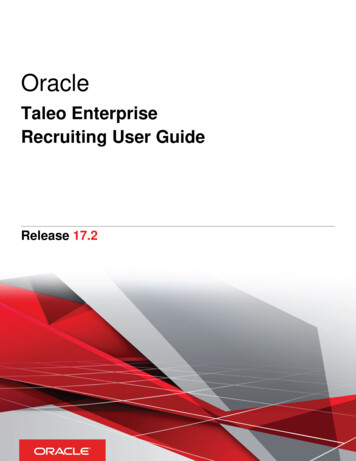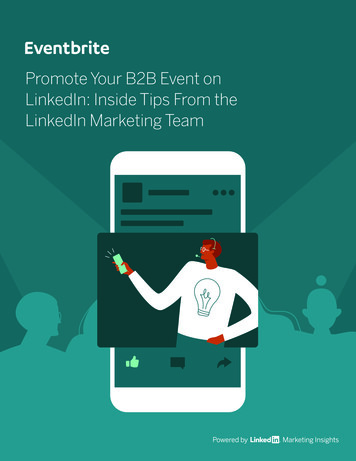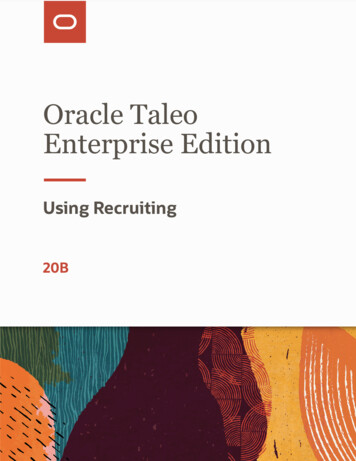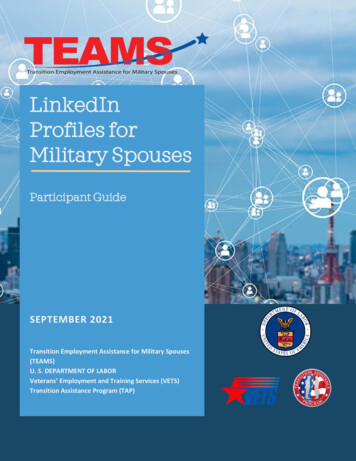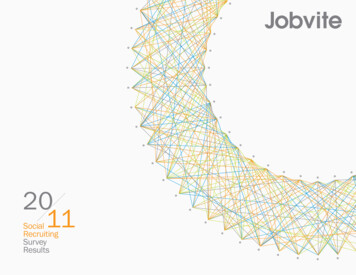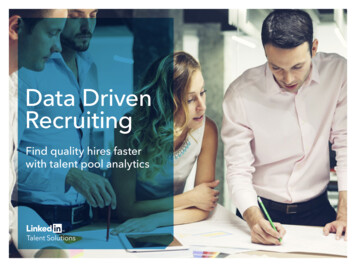
Transcription
Data DrivenRecruitingFind quality hires fasterwith talent pool analytics
Why read this e-bookProblem:Table of contentsIntroductionWhat’s the big deal with data driven recruitingIn the age of social recruiting, there are massive amounts of data andcandidate profiles to wade through. Finding “the one” for your rolecan feel like searching for a purple squirrel.Part 1Three steps to being a strategic talent advisorPart 2How to reasearch and refine your talent poolOpportunity:Part 3Execute your sourcing planPart 4You can’t manage what you can’t measurePart 5Four stories about data driven recruitingConclusionWelcome to the world of data driven recruitingInstead of being overwhelmed by data, organizations can turn it intoa competitive advantage.Never fear, we’re here for you!If the mention of data and analytics gives you hives, don’tworry - we’re here to help! In this e-book we’ll guide you step-by-stepthrough how to find the best person for the job faster, using talentpool insights that will make your hiring manager smile.Data Driven Recruiting2
What’s data drivenrecruiting, anyway?It’s the analysis and interpretation of talent pool data to find the bestpeople for your organization faster. In this e-book, we’ll arm you withthe analytical chops you need to: Ask the right questions about the roles you’re recruiting for; Look for talent pool data to answer those questions; and Interpret that data to provide actionable recommendations tohiring managers.12 out of 3recruiters don’t have the tools necessary to understandthe market and talent pool they are recruiting from1LinkedIn Talent Solutions Survey, (Dec 2014).Data Driven Recruiting3
The bottom-line impactof top talent is real.9XThe best developer at Apple is over 9X more productive thanthe average software engineer at other technology companies.5XThe best blackjack dealer at Caesar’s Palace in Las Vegas playshis table over 5X longer than the average dealer on the Strip.8X“Human capital data can be leveraged to identify and hiremore great people more quickly. but the vast majority ofcompanies have yet to fully embrace data as a strategic assetin talent acquisition.”Glen CatheySVP, Talent Strategy and InnovationKforceThe best sales associate at Nordstrom brings in over 8X morerevenue than the average sales associate at other department stores.6XThe best transplant surgeon at a top medical clinic has a successrate over 6X better than the average transplant surgeon.Bain and Harvard Business ReviewMaking Star Teams Out of Star Players by Michael Mankins, (Jan 2013).Boolean Black BeltBig Data, Data Science, and Moneyball Recruiting, (Sept 2011)LinkedIn Talent Connect interview, (Oct 2014).Data Driven Recruiting4
Data matters for findingtalent faster & more efficientlyTalent acquisition teams with mature analytics are:2X3X“The old fashioned fuddy-duddy HR department is changing.The Geeks have arrived. Today, for the first time in the fifteenyears I’ve been an analyst, human resources departments aregetting serious about analytics. And I mean serious.” 2Josh BersinPrincipal and FounderBersin by Deloittemore likely to improve their recruiting efforts; andmore likely to realize cost reductions and efficiency gainsBersin by Deloitte, WhatWorks Brief: High-Impact TalentAnalytics - Building a World-Class HR Measurement and AnalyticsFunction, (Oct 2013).1Forbes, The Geeks Have Arrived in HR: People Analytics Is Here,(Feb 2015).2Data Driven Recruiting5
Three stepsWhat’sthebigbeingtodeal withdataastrategicdrivenrecruitingtalentadvisor
Hiring manager and recruiterrelationships can be a problem56%“The recruiting organization that figures out how to extractthe value of data will define the future of talent acquisition.”Over half of TA organizations that are reactive and tactical.Recruiters in these organizations act as order takers for hiringmanagers instead of consultative partners.1Brendan Browne80%Senior Director of Global Talent AcquisitionLinkedInMost recruiters think they have a high to very highunderstanding of the jobs they’re recruiting for.261%However, most hiring managers say recruiters have a low tomoderate understanding of the jobs they’re recruiting for.282%of recruiters have recently dealt with a hiring managerwith unrealistic expectations.3Bersin by Deloitte, WhatWorks Brief: High-Impact TalentAnalytics - Building a World-Class HR Measurement and Analytics Function,(Oct 2013).1iCIMS and hire expectations institute, Strategies to Improve theRecruiter and Hiring Manager Relationship, (Oct 2014).3LinkedIn Talent Solutions Survey, (Dec 2014).2Data Driven Recruiting7
When hiring manager andrecruiter relationships areworking, the results are great4XDeveloping relationships with hiring managers is the #1 driver oftalent acquisition performance — 4X more influential than any other.13%of companies have a mature talent acquisition organization,in which recruiters:1. Act as true consultants to hiring managers2. Understand trends in the labor market3. Hold kick-off meetings and establish service-level agreementswith hiring managers4. Use various sourcing tools to build talent pools and pipelines5. Proactively pursue, engage, and convert qualified candidatesBersin by Deloitte, WhatWorks Brief: High Impact Talent Acquisition:Key Findings and Maturity Model, (Sept 2014).Data Driven Recruiting8
Advice on being a strategictalent advisor from yourfellow recruitersSample discussions to have during your hiring managerstrategy meeting: This is what the talent market looks like for the role[Present your research and Total Addressable Market basedon the basic qualifications]. Does this look right? What canwe tweak or deprioritize to get a larger pool of candidates? Based on the background of your current team, are youtrying to fill gaps or go after people with similarbackgrounds? Set expectations on timelines for finding passive candidates.It’s typically a longer process than they might expect. Tell them how often you will communicate progress. Get a commitment from the hiring manager that this is apriority for them, and who on their team will be activeparticipants in the interview process, providing an excellentcandidate experience.How to become a strategicadvisor to the hiring managerHere’s the process werecommend:Step1Have an informationalintake meeting with yourhiring manager2Research and refine yourtarget talent pool with data3Have a follow-upstrategy meeting withyour hiring managerAnne-Marie RyanSenior RecruiterLinkedInData Driven Recruiting9
Step 1Have an informational intakemeeting with the hiring managerWhy:How:To clearly define the role you are recruiting for.The initial intake meeting is critical to get rightbecause the latter stages involve spending a lotof time researching candidates and nurturingprospects in the talent pool you defined.During the meeting, ask questions so you fullyunderstand the role. Get examples of highperformers in these roles now, that your hiringmanager would want to clone.StepNext step:Set up a follow-up meeting to discuss your talentpool findings, tweak your sourcing strategy, andagree on the execution plan.1Have an informationalintake meeting with yourhiring manager2Research and refine yourtarget talent pool with data3Have a follow-upstrategy meeting withyour hiring managerData Driven Recruiting10
Sample hiring managerintake formLocationGeography (Global, Multiple)Job FunctionJob Titles (Max of 20)Job FunctionSeniority LevelAccountingCreativeSenior LevelOwnerYears of experienceNew College Grad1-3 yearsIndustryCurrent or past company - Including specific companies may limit use of additional filtersInclude (Min 5, Max 20)SkillsSkills (Max 10)Exclude (Min 5, Max 20)DegreesDegreesLinkedIn GroupsGroupsData Driven Recruiting11
Step 2Research and refine the targettalent pool with dataWhy:How: To provide your hiring manager with macrolevel insights on the talent supply using data. To set hiring manager expectations if their rolerequirements are too strict. Identify the high performing individuals at yourorganization the hiring manager would want toclone. Create a search that includes them in the resultsto understand the ideal skills, experiences, andeducation you should look for. Refine this search with the criteria you definedwith your hiring manager. Using an intake form as your guide, create anoverview of your target talent pool that you canshare with your hiring manager in your nextconsultation. Gather data on the broader talent marketusing organization-based and exclusive Booleansearch strategies. We’ll dive deeper into how todo this in the next chapter.StepNext step:1Have an informationalintake meeting with yourhiring manager2Research and refine yourtarget talent pool with data3Have a follow-upstrategy meeting withyour hiring managerDecide what you’ll communicate to your hiringmanager in terms of timelines, your sourcingand recruiting plan, how you’d like the hiringmanager to help, and next steps.Data Driven Recruiting12
Step 3Have a follow-up strategymeeting with the hiring managerWhy:How: Get sign-off on the plan before you execute it Educate, tweak role requirements, and agreeon next steps. Share the quantified total addressable market,and other views of your target talent pool youresearched. Ask your hiring manager if the results show thebest people in the world for the role you’retrying to fill. If the original request results in a tiny talent poolof people, it’s probably not a realistic request. Educate your hiring manager on your marketresearch, then work together to refine andremove criteria that aren’t priorities and canexpand your target talent pool. Repeat the saved search, discuss, and refineagain as needed. Set expectations! Remember that you areentering into an agreement with your hiringmanager.Step1Have an informationalintake meeting with yourhiring manager2Research and refine yourtarget talent pool with data3Have a follow-upstrategy meeting withyour hiring managerNext step:Once you agree on the new job descriptionand sourcing strategy, you can begin to prioritizecandidates in your talent pool, research, andreach out.Data Driven Recruiting13
Agree on the target talentpool after removing or alteringjob criteriaOnce you do this with your hiring manager, you will have a realistic talent pool of prospects to go after.Every“requirement”:Remove oralter one:Remove oralter a third:Remove oralter a third:Remove oralter a fourth:3197182126Data Driven Recruiting14
“The hiring manager was frustrated because he felt it wasan easy role to place. I felt that it was a difficult role thatwould take some time. Finally we sat next to each other tolook at LinkedIn Recruiter’s search insights. The hiringmanager said “Wow, your job is really hard. I have no ideahow you do this.” Originally he wanted to fill the role in amonth. Now he agrees that the position will take up to 6months to fill. He also adjusted the criteria from 1 year ofexperience to include those with 3-5 years of experience toexpand the talent pool. When the hiring manager empathizedwith how hard our job is, I got excited. Hiring managers don’tusually understand how in-demand and small a talent pool is,especially with quality talent.”“The purpose of the refine meeting is to go back and getbuy in from the client that you are supporting to make surethat you are aligned on the talent that’s represented in yourtalent pool.”Matt TagueTalent Market Strategist - Lead RecruiterLinkedInBrigitte KearneyStaffing specialistQualcommData Driven Recruiting15
How to researchand refine yourtalent pool
Why build talent poolsusing data77%of recruiters say they aremore efficient in their recruitingefforts when they have a solidunderstanding of the marketand talent pool they’rerecruiting from.75%of recruiters don’t usetalent pool insights duringintake or kickoff meetings withhiring managers.71%Yet 71% say they would if theywere easily available, sharable,and understandable.LinkedIn Talent Solutions Survey, (Dec 2014).Data Driven Recruiting17
Benefits of sharing talent poolinsights with hiring managersBefore:After: Little to no understandingof internal talent pools Deep internal understandingof internal and external talentpools Searching reactively Understand the totaladdressable talent market. Constantly repeatingkeyword searches Search once, prioritize,then refine Hunch-based talentconversations with hiringmanagers Data-driven talentconversations with hiringmanagers2ndCandidate talent pool development is the 2nd most influentialdriver of talent acquisition performance, after hiring managerrelationships.1Data Driven Recruiting18
Learn how to use talent poolinsights for recruiting in 3 steps“Data isn’t new. Getting insight from it also isn’t new. But theamount of data we have access to now, combined with thespeed it comes at us means that the smartest recruitingorganizations are finding new ways to gather and analyzedata at speeds previously unthinkable. And they’re using thatdata not only to make smarter recruiting decisions but toinfluence broader business strategy that determines talentneeds in the first place.”Step1Search onceand save2Dion LoveNarrative Strategist,CEB (CorporateExecutive Board)Interpretthe data3Save your searchesand pipelineData Driven Recruiting19
Step 1Recruit faster - Searchonce then save your searchWhy:How: Similar to a market sizing exercise tounderstand an overall revenue opportunity,you want your hiring manager to understandthe total addressable market of talent you aregoing after. If the total addressable market is too large orsmall, you can refine the job criteria so you havea reasonably-sized talent pool to pursue. Use your hiring manager’s job criteria to createa Boolean search string that captures all theideal qualifications of the role you’re recruitingfor. Alternatively, create a search that will result inthe top talent at your organization that you wantto clone. Then use exclusive search tactics tofind similar talent outside your organization andexclude the types of people you DON’T wantfrom your results. Quantify your total addressable market byrecording the total number of professionals thatfit all of your ideal criteria. Save your search results. Remove criteria that you think could bede-prioritized to see how your totaladdressable market expands. Create a slide that helps your hiring managervisualize and quantify the total addressablemarket for your ideal candidate vs candidateswith low-priority qualifications removed.Step1Search onceand save2Interpretthe data3Save your searchesand pipelineData Driven Recruiting20
Quantify the total addressablemarket for your hiring managerTotal Addressable MarketIndividual possessthe minimum requirementsSoftware Engineer a few desired job requirementsJava AND C Bay AreaIdeal candidatesSoftware Engineer Java AND C Bay Area Medical Industry ERP Technology“When I was sitting withthe hiring manager andlooking at LinkedInRecruiter’s searchinsights, we immediatelyknew if we were castingtoo tight of a net and howwe needed to adjust thecriteria. It allowed meto talk about how big themarket is, and whetherthe hiring managerneeded to adjust hisstrategy. We alsodiscovered companies weweren’t looking at before,that had people with thebackground we wganted.”Brigitte KearneyStaffing specialistQualcommData Driven Recruiting21
Use search insights inLinkedIn RecruiterIn LinkedIn Recruiter, do a search then click on the search insights tool in the upper right hand corner.Data Driven Recruiting22
Get an overview of yourtalent poolUnderstand different aspects of your target talent pool - where they’ve worked before, where they currently work, a breakdown in yearsof experience, a breakdown of years in their current experience, which schools they attended, what they studied, and where they live.Data Driven Recruiting23
Step 2Interpret the talent pool dataWhy:How:Get different views of your talent pool tounderstand where the largest pockets ofcandidates lie.Dig into these suggested views of your talent pool.Play around with the tool to see more interestingcuts of the data.Step1Search onceand save2Interpretthe data3Save your searchesand pipelineData Driven Recruiting24
Prioritize companies withthe largest target talent poolsWhy:How: Get competitive intelligence on which companies have the largesttalent pools of people you’re interested in and prioritize recruitingfrom those companies. By focusing on one organization at a time, you can understandthat organization’s language for jobs and save yourself time. Move from:Before:After:Filter focusedCompany focusedInclusive searches (creatinga Boolean string)Exclusive searches (subtractingcriteria you don’t want, like title intern) Save time by searching once, then refining the same search stringand saving each subsequent search in LinkedIn Recruiter. Find companies with the largest target talent pools. Filters: Select your ideal qualifications (i.e. skills, years ofexperience, etc.) Search Results: Identify terms that are not a fit and start removingthese people. These become the NOT keywords for your searchquery (i.e. NOT intern, NOT CEO, etc). Check if the list of results / people looks right. Once the results look right, save your search and signup to get alerts. Alerts tell you when an organize has promotedsomeone, or when someone has left the organizationso you can keep tabs on your top talent. Go to search insights and click on companies to seewhich companies (both current and past) have the largesttalent pools. Understand where you’ve previously recruited talent from. Select your organization under Current company. Look at the past companies section of search insights tounderstand where you’ve recruited from in the past.Data Driven Recruiting25
Prioritize companieswith largest talent poolsData Driven Recruiting26
Prioritize schools with the largeststudent and alumni talent poolsWhy:How: Speed up your sourcing by prioritizing schools with the largesttalent pools of students and alumni that meet your criteria. Find schools with recent grads in your target talent pool. Re-run your saved Boolean search query with target criteria. Select 1 year or 1-2 years of experience. In the search insights section, click the “Education” tab. This is the recent graduates talent pool with your desiredskills and experiences. Understand which schools have alumni in your target talent pool Repeat the above but under Years of Experience check theoptions you’d like to target. Understand where your organization’s current employeesgraduated from Repeat the above but under Company, enter yourorganization.Data Driven Recruiting27
Sample search insights toprioritize largest student andalumni talent poolsData Driven Recruiting28
Uncover hiddeninternal talent poolsWhy:How:If you work for a medium to large sized organization, there may beinternal talent that fits your qualifications and aren’t already workingin the group you’re recruiting for. They may be slightly junior or thesame level as the role you’re trying to fill, and open to a promotion orlateral move. Using company filters, select both current and past company asyour own. Select ideal # years of experience you’re targeting. To find those who could be promoted, enter keywords of rolesthat are immediately junior to the one you are sourcing for. Identify potential lateral transfers by excluding people in thejunior role.Data Driven Recruiting29
Search for referral talentin your hiring manager’snetworkWhy:How:Chances are, your hiring manager will know qualified peoplebecause of network effects. As the theory goes, birds of a featherflock together. Communicate with your hiring manager that you will use LinkedInRecruiter to target talent in his or her network. Connect with your hiring manager so you can see his/herconnections on LinkedIn. Navigate to your Hiring Manager’s profile in LinkedIn Recruiter. Click on connections. Source your hiring manager’s connections using the search stringyou created. To visually summarize the talent pool that is in his/her network,in search insights click on the Compare All tab. Recommend a messaging strategy for referral candidate outreach.Craft a message for the hiring manager to use to reach outdirectly to candidates.Data Driven Recruiting30
Step 3Save your searchesand pipelineWhy:How:1. This will save you a tremendous amount of timeand work in the long run. You’ll no longer needto re-enter search criteria and filters each timeyou look for candidates.2. Help your teammates and manager track yourprogress and help you as needed.1. As you identify different talent pools, save yoursearch query, save your filter sets as customfilters, and save leads to your project / pipeline.2. Add a note to leads referencing the name ofthe talent pool you’re sourcing for.3. Use notes to indicate which individuals you’vebegun sourcing and outreach with.Step1Search onceand save2Interpretthe data3Save your searchesand pipelinePro tip:Use the update featurein LinkedIn Recruiter to get alerts on whensomeone in your target talent pool has beenpromoted or has left the organization.Data Driven Recruiting31
Resources to get started withusing talent pool insights:1. Free LinkedIn talent pool reports on SlideShare:lnkd.in/plan2. Search Visualization tool in LinkedIn Recruiter.Contact us to learn more.Data Driven Recruiting32
What LinkedIn’s free talentpool reports will tell you:Try exclusive search tacticsyourself in 15 minutes!1. Which cities to target by understanding macro talent supplyAND demand data.2. Which LinkedIn groups to target by seeing which groups aremost popular.3. How to craft your InMail messages by understanding what yourtarget talent pool values in a job.1. Create an organization-based search for your target talent poola. Enter keywords for your role.b. Under Current company, enter your target organization.c. Filters: Select fixed requirements (i.e. Years of experience,Location, etc.).2. Refine your searcha. Identify terms that are not a fit and begin removingthese terms.b. These terms become the NOT keywords for yoursearch query.c. Save search and Get alerts. Alerts will tell you when someoneis promoted or leaving.Data Driven Recruiting33
ExecutetheWhat’sbig dealyoursourcingwithdata drivenplanrecruiting
Put your sourcing andrecruiting plan into action:1. Prioritize candidates that are most likely to respond and are thebest match for your organization.2. Research and referral check high potential candidates byinterviewing connected employees.Step13. Contact candidates by reaching out through mutual 2nd or 3rddegree connections. This is proven to be more effective than coldcontacting.Prioritize4. Pipeline proactively to track your nurture process andcollaborate with your team. Proactively nurture relationshipswith top candidates, even if they aren’t looking to switch at thatmoment. Help them become aware of your organization, want towork there, and eventually convert into candidates. Tag them inyour system as high potential candidates you may want to goback to.Research andreferral check23Contact throughmutual connections4PipelineproactivelyData Driven Recruiting35
Target different talent poolsegments with different typesof outreach.CustomerAcquisition FunnelMarketingSalesCandidateAcquisition ruiting1:1Data Driven Recruiting36
Step 1Prioritize prospects in youragreed-upon talent poolWhy:How:You’ll end up with hundreds and sometimeseven thousands of target candidates in yourtalent pool. It’s important to prioritize yourtime with this list wisely. Once you’ve agreed on the overall talent poolwith your hiring manager, we recommendprioritizing the prospects with the highestmatch and some affinity toward theorganization to maximize the likelihoodof getting a response. Prioritize prospects who are the best match,from the top half of your LinkedIn searchresults. All of your search results meet yoursearch requirements, but you can now takeadvantage of LinkedIn’s new search relevancyenhancements that better prioritize thoseresults by taking into account signals ofinterest and fit. Prioritize prospects with some affinity towardyour organization by looking at the prospectswho are most connected to your employees,are following your organization, have optedinto your talent community, etc. Top priority talent should receive 1:1 InMailand referral attention. Second priority talent requires a 1:Manystrategy. Use LinkedIn’s Work With Us ads, anemail or InMail nurture campaign, etc. to reachthese segments.Step1Prioritize2Research andreferral check3Contact throughmutual connections4PipelineproactivelyData Driven Recruiting37
How to prioritize prospectsin your talent poolHighPrioritizeHere!MatchLowAffinityHighData Driven Recruiting38
Step 2Research and referral checkhigh potential candidates beforereaching outWhy:How: Get a fair view of high potential candidatesbefore reaching out, and save yourself time andheadache later. Take advantage of your colleagues’ knowledgein two key areas: What it takes to be successful at yourorganization. Their deeper understanding of the prospects’ skills and aspirations. Reach out to employees connected to eachprospect. Keep your questions open soemployeesshare their thoughts freely. Ask open endedquestions such as: What are your thoughts on this person? How do you see this person fitting in at ourorganization? What did they do when you workedtogether? Record their feedback and decide whether youshould go after that prospect.Step1Prioritize2Research andreferral check3Contact throughmutual connections4PipelineproactivelyData Driven Recruiting39
Why warm outreach worksOnce you’ve advised the hiring manager and set expectations usingtalent pool data, it’s time to prioritize, research, and reach out!Instead of cold calling, try reaching out to your prospects through asecond degree connection like an employee. Why? The results speakfor themselves.Results of using the warm outreach method at LinkedIn:85%Average InMail response rateswhen 1st degree employees reached out28%Average InMail response rateswhen recruiters reached out“The referral insight gathering process is really where therubber meets the road. It’s where we actually get to validatethis great data that we’ve been using.”Bob SpoerFormer Talent Market Strategist Engineering, LinkedIn.Currently Chief Entrepreneur for People/Search/Partnerships, Ashoka.Data Driven Recruiting40
Step 3Contact candidates throughmutual connectionsWhy:How: There’s no reason to reach out cold in aconnected world where you have LinkedIn! By reaching out to passive candidatesthrough a warm contact or after sharing awarm contact’s recommendations with passivecandidates in an InMail, you can make themost of the trusted relationship betweenthe prospect and the mutual connection. Your goal with passive candidate sourcingshould be for the person to have a careerconversation with the hiring manager,even if the candidate isn’t 100% surehe/she is interested. After making sure you have the right peoplein the talent pool by validating with your hiringmanager and gathering additional referral datafrom employees, it’s time to start reaching out. Build a relationship with the prospect and usethe data gathered in the research phase tofigure out the best way to approach theindividual. The recruiter is responsible fordeveloping the outreach strategy andfacilitating the process. Ideally, the outreachwill be done by the employee or mutualconnection that has the deepest connectionto the individual to increase the chances of aresponse. The recruiter should figure out the best way tocontact the prospect First choice – Most connected employee 2nd choice – Hiring Manager 3rd choice – Recruiter If the prospect isn’t responsive: Understand whether the outreach wasspecific enough. Maybe they aren’t interested in having acareer discussion.Step1Prioritize2Research andreferral check3Contact throughmutual connections4PipelineproactivelyData Driven Recruiting41
Step 4Pipeline candidatesproactivelyWhy:How: By proactively pipelining for high priority rolesinstead of reacting to every new job posting,organizations can monitor and increase thespeed and effectiveness of their recruitingteams. By transitioning from reactive recruiting to proactive pipelining, recruiters can free up theirtime for strategic conversations with hiringmanagers about the desired future skillsmake-up of their teams. Proactive pipelining comes down to theprocesses and tracking of individual recruiters. Once these statuses are added, recruiters andrecruiting leaders can then see where in thefunnel their prospects fall and track speedand progress.Step1Prioritize2Research andreferral check3Contact throughmutual connections4PipelineproactivelyData Driven Recruiting42
To pipeline, use thesesample tags and statusesNew Prospect:This prospect has just been added to the talent pool and hasn’tmoved through the process.Not Interested:The prospect has responded to our outreach but has indicated thatthey are not interested in engaging.Reference Check Pending:A Reference Check has been requested, however we still need togather two or more pieces of positive feedback on the prospectbefore moving forward.Not a fit for this role:We determined that this prospect is not someone we want to engagewith right now based on their skills.Outreach TA:Somebody on the talent acquisition team has made an outreach tothe prospect.Nurture:The prospect is in the Nurture phase and is receiving regular “Nurture” activities from the right person.Outreach EE:An employee has reached out to the prospect to engage them.Moved to ATS:This prospect has decided to apply for a role at your organizationand enter the recruiting process via the applicant tracking system.Outreach
Recruiters in these organizations act as order takers for hiring managers instead of consultative partners.1 However, most hiring managers say recruiters have a low to moderate understanding of the jobs they're recruiting for.2 Most recruiters think they have a high to very high understanding of the jobs they're recruiting for.2
